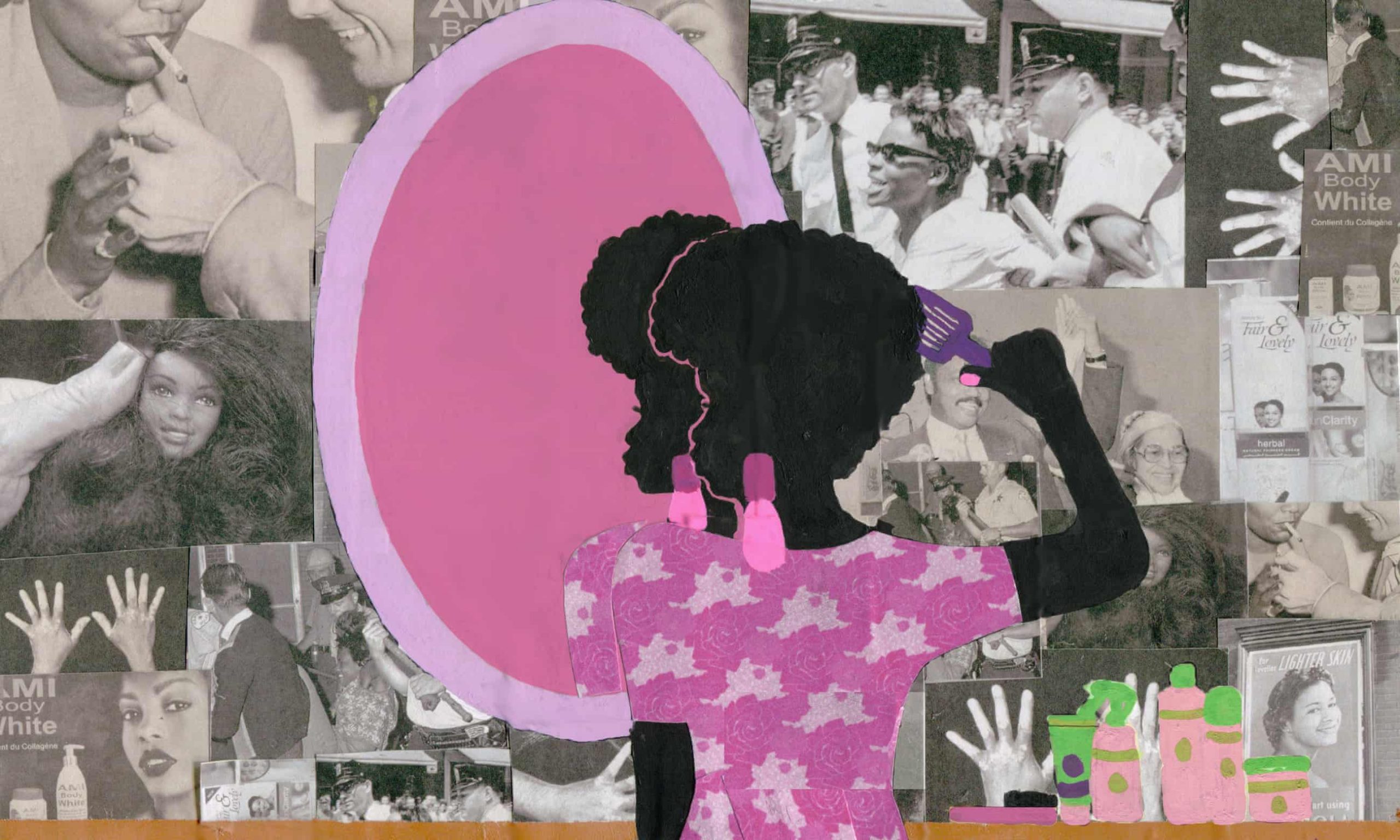This Article First Appeared on: TheGuardian
Written By: Kaitlyn Greenidge
My grandmother was a great beauty. Everybody said so.
“Like a black Elizabeth Taylor,” was the comment heard most often, because her eyes looked violet in some light. She had a perfect hourglass figure, large clear eyes, a tiny waist, long slim hands, a killer sense of dress and smooth dark skin.
The only trait I shared with her was her skin color. My mother always spoke of this with pride. It was a treasure to be kept whole through diligent care – applications of thick, pasty Eucerin lotion, which used to come in a tub, worked into the skin as it melted down and made everything smooth and shiny. My grandmother used the silkier Nivea instead – kept on the dresser in her all-white bedroom, applied throughout the day. The smell of it still reminds me of the elegance of her life.
That dark skin was the most beautiful was the logic of my family. Growing up, all my Barbies and baby dolls had skin as dark as mine. This was my mother’s conscious choice. She stocked our bookshelves with black children’s books, bought toys and games with black characters. She worked hard to make sure our home was a place where blackness was always celebrated. She was keenly aware, as the mother of three black girls, how the world would treat us, regardless of our varying shades.
Looking back, I think this probably had to do with her own skin color – my mother was much lighter than my grandmother, with a spray of freckles across her nose. In my grandmother’s house, my mother’s high school portrait sat on the mantle – it was a photograph retouched with oil. The painter had lightened my mother’s skin to an anemic grayish yellow, given her green eyes, and thinned her nose. “He thought she was Italian,” I remember my grandmother telling me, as explanation. My mother hated that picture, the erasure of her blackness. I haven’t seen it since my grandmother died.
Growing up in the supportive environment my mother created for us, I assumed into early adulthood that colorism was a thing of the past. Colorism – the prejudice based on skin tone, usually with a marked preference for lighter-skinned people – was something I read about in novels. It seemed quaint, like pin curls or cellophane. There was a slight troubling when I would watch TV shows such as Martin or movies like Coming to America, and the love interest was always light and the girls my color were shrews – too fast, too forward, too sarcastic to be loved. But at least these were movies with people who looked like me, and it hurt less to ignore my misgivings and just enjoy seeing a woman like myself on the screen, even if she was there only for the protagonist to screw his face up at in disgust.Advertisement
For reassurance that these scenarios were just fiction, all I had to do was look at my grandparents’ marriage – my grandmother as dark as me and my grandfather, who adored her, much lighter.
It is a sad and sobering fact to realize that color – how dark or light you are perceived as being by a prospective partner, who most likely is someone of your own race – sometimes determines who in our communities is deemed deserving of romance. The question of desirability, of who we believe is worthy of love, is what led me to read more about colorism.
In the last two years, I’ve been researching a novel about a young black woman living in 1870s New York City and Jacmel, Haiti, during Reconstruction. As I imagined her life, I realized how much color would play into her experience. She is the dark-skinned daughter of a light-enough-to-pass bourgeois black woman, and the family’s background ensures her a place in the emerging black middle class, but her complexion keeps her from ever feeling truly welcome there.

I went deeper into my colorism research, and what I found let me know that colorism is still alive and well. I started with the marriage market, and found out dark-skinned women are less likely to be married than lighter-skinned women. But colorism shows up in even starker ways: the difference in pay rates between darker-skinned and lighter-skinned men mirrors the differences in pay between whites and blacks. Darker-skinned women are given longer prison sentences than their light-skinned counterparts. And this discrimination starts young – if you are a dark-skinned girl, you are three times more likely to be suspended from school than your light skinned peers.Advertisementhttps://8df1ae8edd3edb0fc1ba0ca89e0149a8.safeframe.googlesyndication.com/safeframe/1-0-37/html/container.html
Even more insidious, colorism even affects how we are remembered. Lighter-skinned black people are perceived to be more intelligent. Educated black people, regardless of their actual skin color, are remembered by job interviewers as having lighter skin.
The daily toll of living with colorism is inescapable. Darker-skinned people report higher experiences of microaggressions; heavier-set dark-skinned men report the highest levels of microaggressions. All of this affects our mental health and wellbeing. Darker-skinned black women report more physiological deterioration and self-report worse health than lighter-skinned women. Taking all of this into account, I cannot help to think how the weight of history comes to bear on our daily living today.
Wage and punishment inequity and our skewed perception by the professional world make more sense to me, because they operate on the cold logic of white supremacy. They are describing interactions with a wider, non-black world and take into account how both white and black people view skin color. But the facts around relationships and dating don’t make any sense to me: given the relatively low rates of interracial marriage for black women in the US, we are talking about perceptions and prejudices within the black community – how we treat each other, our own internalized white supremacy.
To understand colorism, perhaps, we have to understand self-perception. Margaret Hunter, a sociologist who published her findings on colorism, marriage and dating in black and Hispanic communities in the 1990s, noted, “Different communities define it differently. There’s no clear lines about those definitions. The best research tends to use color palette to ask people how they see themselves. Because whether or not you say you’re light skin or dark skin is relative to your social context and that varies by what kind of community you live in.
I began to realize the importance of distinguishing between colorism as practiced by white power structures like courts, schools and businesses, and colorism as practiced within the black community, evidenced when we talk about marriage statistics and measurements of color.
The former seems easier for many black people to acknowledge. The latter is less explicitly talked about. To do so is to begin to unpack internalized white supremacy, something most people are unwilling to do because it can be so painful.

When the conversations do arise, they often get stuck on personal experiences – the proverbial light-skinned girl who claims all the girls hated her in junior high, or the dark-skinned girl who says the same. Rarely do we point to how these experiences are part of a long, complicated history. But if we can trace the origins of colorism we can perhaps begin to find a way to heal from it.
As long as colorism has existed in our communities, there has been a vested interest in denying its existence. The term does not appear until 1983. It is widely credited to Alice Walker, in her classic womanist text In Search of our Mothers’ Gardens.Before that, black Americans used other terms, like “colorstruck” or “colorphobia”. It is significant that an attempt to define this phenomenon came from black womanist theory, a field of scholarship that attempts to link the knotty legacies of race, gender, exploitation and self-actualization. And it makes sense that Walker would deem colorism worthy of study since its effect is keenly felt by black women due to its ties to perceived attractiveness, femininity and sexuality.
But what had kept black people from naming it for so long, and what keeps us from talking about it now? The history of this denial was a driving question for me.
Colorism is not just an American phenomenon. It’s global. Skin bleaching cream is sold in majority-black or people of color countries throughout the world. The most far-reaching conversations I’ve had about it have been with women of color.
I am friends with the writers Tanaïs and Mira Jacob. Although they are not AfricanAmerican, their communities – Jacob identifies as Indian American, Tanaïs as Bangladeshi American – have their own versions of colorism. In text chains that started as check-ins about how to navigate life as writers, we talked about the expectations of performing gratitude and overworking, and we each began to link this to our experiences as dark-skinned women in our respective communities.

We talked about how it affected who we tried to date, how easily we were underestimated, how often we were expected to work for free, be grateful, be humble, and the intense backlash that we each experienced when we didn’t act accordingly.
We talked about who was respected for their craft, who was deemed a literary darling, and who was not. “Have you ever noticed, the women of color writers who are championed as ingenues or geniuses are almost always light-skinned?” A question I typed out into the thread, knowing it was a place to be able to unpack and figure out the complications around these feelings.
Recently, I wrote to them: “What makes this all so hard to talk about is the internalized white supremacy. If white people disappeared from the planet tomorrow, colorism would still exist in our communities, and that is maybe the most painful part. Why people would rather say it isn’t real.”
To try to answer this question, I began to research the roots of colorism in the US. As far as I can tell, it starts, like so much of our culture, in the system of chattel slavery. In the US, unlike in other systems of slavery in other time periods, to be a slave meant you were legally a nonperson – unable to enter into legal contracts like marriage or land ownership, and not considered a citizen. Whiteness meant that blackness meant a person was property. Slavery was inherited, and whether or not you were considered a slave was dependent on the status of your mother. This system ensured that white male slave owners who had children with the black women they enslaved contributed to their own wealth.
Under this system, proximity to whiteness could increase your chances for freedom. If you had a white father, and more importantly, if you “looked” white, the easier you could potentially claim some sort of freedom.
In the US, our current understanding of colorism, though, stems from the decades directly after slavery, when everyone was theoretically free and a citizen regardless of race. This meant the amount of color in skin, not just skin color, became paramount for whites to maintain social and economic control. The one-drop rule – that even one distant black relative meant a person was black, or at least, most definitely, “not white” – increasingly became a way to define people.

This is not to suggest that during slavery there was some sort of pan-racial understanding of color. Only that before widespread emancipation, there was some leeway in defining mixed-race people’s heritage. The most famous example of this is the history of the creole communities of New Orleans, Louisiana, and Charleston, South Carolina – spaces where the descendants of black enslaved women and white slave owners could establish their own communities as free people of color. This leeway gradually disappeared in the latter half of the 19th century, as legalized segregation hardened into the daily realities of every American.
As more black people obtained freedom after the civil war, and began establishing newspapers – vibrant spaces to define and keep record of what it meant to be this new thing, a black citizen of the US – some of the African American newspapers struggled to call colorism exactly what it was.
In Aristocrats of Color: The Black Elite, 1880-1920, released in 2000, author Willard B Gatewood notes that darker-skinned reporters pointed out that black churches were often divided by color and that political positions and government positions were won based on complexion. In contrast, those in the upper classes insisted that there was no preference at play, pointing to the existence of working-class and poor light-skinned people as proof that color did not directly correlate to an unfair advantage.
The debate, mired in frustration and denial, mirrors conversations around colorism and privilege today.
In the decades after emancipation, the debate shifted from how it felt to experience colorism (usually arguments made by darker-skinned, middle- and working-class writers) to whether or not it actually existed (a point usually made by upper-class writers, some of whom were able to “pass” as white).
Gatewood quotes Nannie H Burroughs, a dark-skinned civil rights activist and educator, remarked in a 1904 speech as saying: “Many Negroes have colorphobia as badly as the white folks have Negrophobia.” She continued: “The white man who crosses the line and leaves an heir is doing a favor for some black man who would marry the most debased woman, whose only stock in trade is her color, in preference for the most royal queen in ebony.”
Compare this with one of Burroughs’ contemporaries, the light-skinned Alice Dunbar Nelson. Both Burroughs and Nelson were schoolteachers, but Burroughs was denied a place in DC public schools because she was dark-skinned, while Nelson flourished.
Famous for marrying the much darker-skinned poet Paul Laurence Dunbar, Dunbar Nelson identified as both an African American author and activist and was deeply conflicted around the subject of color.

She did attempt to write about her complicated feelings; in her essay Brass Ankles she described the persecution she believed she experienced from other children growing up and from dark-skinned teachers in her workplace. “To complain would be only to bring upon themselves another storm of abuse and fury,” she wrote. But the essay was unpublished – Dunbar Nelson did not want to publish it under her own name and black journals refused to publish it under a pseudonym.Advertisement
And so again, we fell into another silence.
I think about these two women – the outspokenness of Burroughs and Dunbar Nelson, obsessed with color but self-aware enough to avoid talking about it in public. I wonder where that shame originates, and trace it, for Americans back, to the origin of the variety of skin colors in our community. You cannot separate the often painful stereotypes of colorism from misogyny, in part because of the fundamental fact that light-skinned black people’s heritage in the US stems from the practice of sexual slavery, sexual abuse and sexual exploitation inherent in American slavery.
This profound trauma explains, to me at least, why this discussion is suffused in so much denial.
I am not sure how we get free from the trap of colorism, but as with most things in life, I know it begins with being able to talk about it openly. When I was a child, the love and pride my grandmother took in her color, the assumption of dignity and elegance, was an unspoken guide to how to navigate the world.
But I think the time has come to be explicit in our strategies, to have the difficult conversations, to acknowledge when they make us uncomfortable, or remind us of our own individual pain. To have your life dictated by something you are not even allowed to name is a special kind of cruelty. The way to begin to combat it is to try to speak about it.
Dream McClinton contributed some research. Share your experience of colorism: use the hashtag #ShadesofBlack on social media

